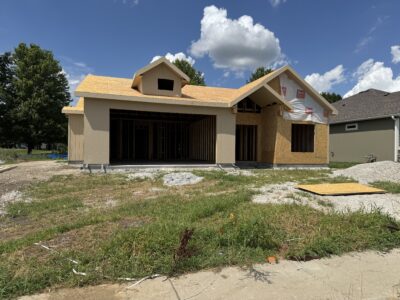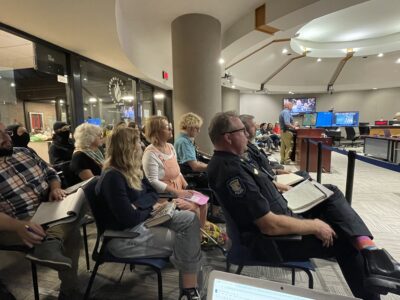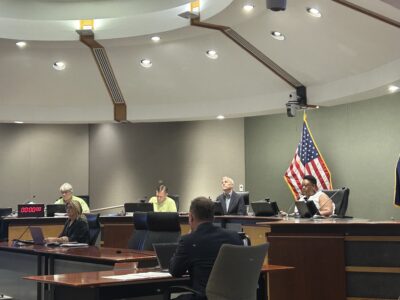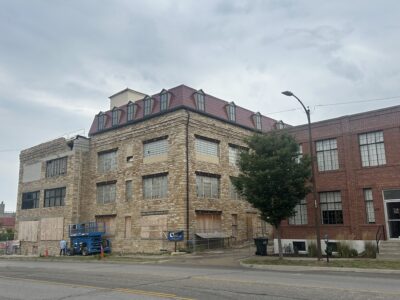Lawrence fire department’s 100-year history reveals much change, but some things remain the same

(Photo courtesy of the Lawrence/Douglas County Fire & Medical).Crew at #1 station in 1955..From left, D. Knight, S. (Buddy) Griffin, D. Headley, M. Lisher, J. Prentice, N. Buffington, unidentified, B. Deay, L. Anderson, K. Dean, C. (Beef) Brubaker, C. (Duchman) Flory, J. Todd, Sam Brubaker, J. Kasberger (Asst. Chief), J. Miller (Chief), F. Sanders (Asst. Chief), unidentified.
At 93 years old, Sam Brubaker has been alive almost as long as the fire department in which he spent nearly three decades has been a municipal entity.
Brubaker, of Lawrence, joined the Lawrence Fire Department — now known as Lawrence-Douglas County Fire Medical — in 1947 after returning home from World War II the previous year. Firefighting was markedly different then, he said, working in a world where fires were fought without masks and rescue ladders were wooden.
“Toward the end, we got two Chem-Ox systems, but the canisters were $4.95 each, so the chief said not to use them,” Brubaker said. “And until the last few years I was there, all fire trucks had solid rubber tires and open cabs.”
The department’s a lot different now, as LDCFM marks its 100th anniversary as a municipal fire department. Since 1915, LDCFM has gone from 10 paid firefighters to 140, one station to five and horse-drawn carriages to $1 million fire engines. Today’s firefighters are also certified medics, so the EMS personnel taking you away in an ambulance might be fighting a house fire on the next call.

Lawrence-Douglas County Fire Medical has seen much change over its past 100 years as a municipal fire department. At 93 years old, Sam Brubaker has been alive almost as long as the fire department in which he spent nearly three decades has been a municipal entity. Brubaker, of Lawrence, joined the Lawrence Fire Department — now known as Lawrence-Douglas County Fire Medical — in 1947 after returning home from World War II the previous year.

(Photo courtesy of the Lawrence/Douglas County Fire & Medical).Crew at #1 station in 1955..From left, D. Knight, S. (Buddy) Griffin, D. Headley, M. Lisher, J. Prentice, N. Buffington, unidentified, B. Deay, L. Anderson, K. Dean, C. (Beef) Brubaker, C. (Duchman) Flory, J. Todd, Sam Brubaker, J. Kasberger (Asst. Chief), J. Miller (Chief), F. Sanders (Asst. Chief), unidentified.
Back in 1947, things were tough — especially for new firefighters, Brubaker recalled. When he first started on the department, he couldn’t understand how the maskless senior firefighters could rush into a burning building without being overcome by the smoke and heat. Brubaker recalled with humor the fire chief — who at that time was Chief Paul Ingles — would give the youngsters tips, but “the guys” wouldn’t.
“They would keep their nose next to that water hose. The water would give off oxygen,” Brubaker said. “I was 10 feet behind them, and I’d get nothing but smoke. I’d be choking to death to catch up with them.”
He didn’t stay the new guy forever, working his way up to captain before retiring in 1973. Since then, many have joined, climbed the ranks and retired after him.
“They fight fires now in all different ways than we did,” Brubaker said. “But a fire’s a fire; it doesn’t matter how you fight it as long as you get them out.”
The early days
Brubaker isn’t the first firefighter to say after the end of his career that the “new guys” have it easier. Looking through newspaper archives, many a former chief interviewed said their generation of firefighters had it tougher than those after.
In a 1953 Journal-World article that ran just before former chief Ingles’ retirement, Ingles said, “Here’s a scene that’s changed a little during the past 40 years.” Reporter Rich Clarkson called Ingles’ quote the “understatement of the day.”
In the article, Ingles recalled the days of horse-drawn fire wagons and an alarm bell atop the fire station to summon firefighters to the station. When Ingles started his career in 1912, the department wasn’t even a “department” yet. It would not change from a volunteer organization to a paid municipal fire department until 1915.
And 21 years before Ingles’ departure, former chief William Reinisch ended his career, remarking in an article that the “youngsters” of 1932 “who fight fires now do not realize what it meant in the old days.”
“We had no warm clothing, no rubber suits to keep us dry and no equipment with which to do much,” Reinisch said. “If we got a hot one it meant getting soaked to the skin and staying with it, winter or summer.”
“I guess some of that is showing up now that I’m getting old,” Reinisch said after his 38-year career as a Lawrence firefighter.
New world, different problems
Now, firefighters not only wear masks but also thermal-lined, thick rubber boots (in Brubaker’s day, their rubber boots were no more than your typical rain boot).
Firefighters today also wear heavy, thermal garments with layers of fire- and chemical-resistant fabric, all of which are fit to each firefighter so that there are no gaps of skin showing when worn, current LDCFM fire chief Mark Bradford said. Brubaker, meanwhile, said his firefighting getup consisted of blue jeans and a raincoat.
Even the helmets are different, as modern helmets are constructed similar to football helmets, Bradford said, with the crown specially designed to protect the head from impact. In Brubaker’s day, helmets were like hardhats, as Bradford said they were essentially a “pressed-out piece of plastic.” Plus, each firefighter wears a mask that feeds compressed air to their lungs, even in the midst of thick, black smoke.
The biggest change, Bradford said, is the influence of technology. Firefighters now have access to computers with important information in emergencies, including GPS, floor plans of more than 500 Lawrence buildings, hazards in those buildings and even how much water is left in hydrants close to the fire at hand. This information lets firefighters save valuable time and create strategies when they see what they’re up against.
But it’s not just the firefighting that’s changed, Bradford said, it’s also the fires themselves. Previously, homes, furniture and other items were made with predominantly metal, wood and other natural products. Now, there are more plastics, composites and other materials that not only produce hazardous chemicals, but also burn hotter and faster, Bradford said.
“There are hotter temperatures inside as plastics melt and materials burn,” Bradford said. “Hence, we have to have coats and helmets because it used to be not near as hot as it is today.”
The byproducts of those artificial materials are also dangerous to inhale, causing cancer rates of firefighters to increase nationwide over the years.
“Think of a campfire; you can breathe some of that smoke,” Bradford said. “But the smoke that comes off houses now is combined with all of these chemical gasses that change composition when heated.”
What hasn’t wavered over LDCFM’s 100-year history are the basic qualifications a firefighter must have, according to Ingles, as he laid out in a 1952 Journal-World article:
“A good heart and a good pair of legs … but the first qualification is complete honesty.”
A look back
Ten notable fires over the Lawrence fire department’s 100 years:
- Oct. 7, 2005, Boardwalk fire: Three people — Yolanda Riddle, Jose Gonzalez and Nicole Bingham — died and 20 were injured in an early morning blaze at Boardwalk Apartments, 524 Fireside Drive. Many had broken bones from escaping through second- and third-story windows as they fled the flames that destroyed the 76-unit apartment building. Investigators would later learn 20-year-old Jason Allen Rose set the fire, and he was convicted in 2007 of involuntary manslaughter, aggravated arson and seven counts of aggravated battery in connection with the case. He was sentenced to 10 years in prison, but was released in 2014 because of time-served credit he earned in jail before his conviction.
- April 20, 1970, Kansas University Union fire: A still-unidentified arsonist set fire to the Kansas Union, 1301 Jayhawk Blvd., amid unrest and a tumultuous year of violent protests against inequalities, war, the draft and the establishment. Firefighters responded as flames burst through the roof. Fire department records indicate all personnel — even those who were off-duty — were called to help and “the maximum amount of water” was placed on the fire. The fire took 12 hours to extinguish and caused more than $1 million in damages.
- July 17, 1986, Rimrock Drive fatal fire: David Winebrenner, 21 at the time, set fire to his parents’ home at 3028 Rimrock Drive while they were sleeping inside because he was angry about not being able to drive the family’s new truck. The Winebrenners escaped from the home unharmed, but a roof beam collapsed and killed 34-year-old firefighter Mark Blair while he was inside searching for other occupants. Winebrenner spent nearly 22 years in prison for Blair’s death before his release in 2009. Blair was the first — and only — Lawrence firefighter to die in the line of duty.
- Sept. 17, 2006, New Jersey Street fatal fire: An early morning fire killed Charles Glover Sr., 66, and his grandchildren, Nolan Vender, 13, DaVonte Brockman, 11, Mario Johnson, 2, and Mariyana Johnson, 1. Glover’s wife, Learlean, survived the fire. The house was entirely destroyed. Fire investigators were never able to determine the fire’s cause, but said there were no indications of any criminal activity. City Hall at the time released an announcement that said, “The heavy damage to the structure, as well as the absence of witnesses, contributed to the inability to identify electrical or human factor as the cause.”
- Jan. 14, 1922, barbershop fire: Lawrence firefighters were alerted to a fire in the basement of a barbershop at 921 Massachusetts Street at 7:40 p.m. Jan. 14, 1922. But before firefighters could get the flames under control, the fire had spread and affected the following neighboring downtown businesses: Bell’s Music Store, Stoffer Drugs, Ward’s Flower Shop, Welch and Welch Chiropractors, Doctor Tibbers’, Vogt’s, Doctor Gifford’s, Mrs. Wagghan’s shop and the Bittie Farm Association. Damages were estimated at $62,000.
- Aug. 24, 1954 Sterling building fire: A fire tore through the second-story storage area of the former Sterling Furniture Co. at 938 Massachusetts St. Several firefighters were overcome by the extensive flames and smoke and one collapsed after fighting the blaze, according to a Journal-World article. Luckily, the firefighters were OK after some rest, and no one suffered any serious injuries. Damages were estimated at $50,000.
- March 1955 Patee Theater fire: The alleyway between the Antique Mall and Dutch Boy Paints in the 800 block of Massachusetts Street was once home to the Patee movie theater. But in March 1955, a fire broke out, destroying the theater “considered the first-ever theater to operate west of the Mississippi River,” according to a Journal-World article from the time. Although no one was injured, a section of the balcony dropped onto the seats below and all available firemen were called to keep the fire from spreading to neighboring businesses. Loss was estimated at $60,000.
- Sept. 10, 1955, Plymouth Congregational fire: In the early morning hours of Sept. 10, 1955, a fire tore through the Plymouth Congregational Church, 925 Vermont St. Each of the 25 men on the Lawrence Fire Department were called to battle the blaze, and it took about two and a half hours to extinguish. Afterward, the firefighters were required to get tetanus shots because they’d received many scratches and scrapes during the incident. Damages were estimated at more than $100,000.
- Oct. 7, 1967, Popcorn plant fire: Firefighters spent more than seven hours fighting a fire at TNT Product Inc., a popcorn plant that held at least a million pounds of unpackaged popcorn in the building’s second floor. The building, originally home to the Barteldes Seed Co. in 1867, was completely destroyed in the fire. Damages were estimated at more than $250,000.
- Oct. 5, 1953, Higgins house fatal fire: An oil stove inside a home at Seventh and Grant streets in North Lawrence caused the residence to catch fire just before 7:30 a.m. Oct. 5, 1953. When the fire department arrived, the home was “totally engulfed in flames,” according to fire department records. A woman identified as Charles John Higgins’ wife died in the fire.







